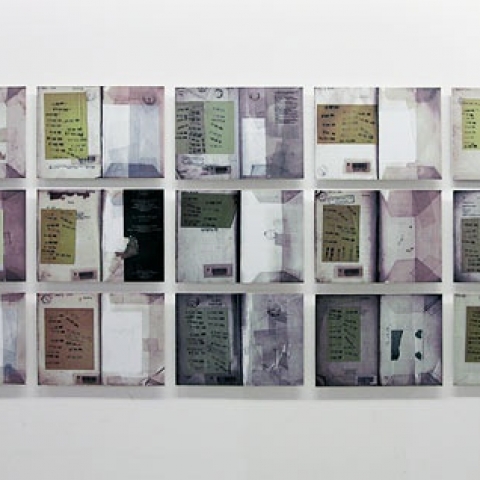My interest in the book Fantasies and Realities (Fantasmes et réalités, 2008) led me to consider other writings by Jean-Jacques Deluz, namely Urban Chronicle (Chronique urbaine, 2001) or The Whole and the Fragment (Le tout et le fragment, 2010), in which the author shares his thoughts on architecture and urbanism, being at times fascinated with a certain number of architectural works and at other times, outraged at the inconsistencies of the new districts that are built in a hasty manner and classified in the aesthetics of emergency that Algeria has witnessed since its independence.
As soon as I read Deluz's writings, I instantly thought of transforming them into a visual arts work, while reflecting upon a final result that would include an installation or a sculpture- since the subject is architecture and buildings, which are synonymous with volume and space. But as I conducted my research, I discovered the wealth of his thinking which offered the possibility of expression through a wide variety of media, ranging from video to documentary film, and even audio works.
Extracts
If I take a closer look at what is happening in Algeria, I'll find great confusion. Architects, influenced by dogmas taught in schools, are resolutely turned towards current trends and produce when they can, formal architectures full of bookish references. Powerful men, mostly…
---
…Motivated by appearances, want prestige; the resident, the ordinary citizen, rich or poor, plans fantasies; and businesses, indifferent to the aesthetic quality or simply ignorant, produces anonymous goods.
The conclusion is therefore negative. If there is no architecture in Algeria, (I leave the exceptions aside) it is because the vision we have of it at all levels, architects, developers, citizens, remains attached to the illusion that aesthetic quality is in transmitting patterns; we all saw the dead end where that belief led.
---
Opposite to this, there is the STANDARD; and the standard is a tool for the lazy one. To the extent that it defines a model which, instead of being a threshold not to cross, is accepted as an absolute value, it becomes an arbitrary obligation; e.g. the standard for the surface of a three-room house, set at 70 square meters of living space, could be at least this surface, while having a few extra square meters, which would satisfy certain applicants. This would simply be resolved by setting the prices to the surface in the right perspective and by making smart allocations.
If I take the AADI's operations which I know well since I worked on 2,000 units for this organization in the new city of Sidi Abdellah, the specifications were strictly standardized in the bad sense of the word: we only had to build three-rooms housings with 70 square meters of living space, and four-rooms housings of 85 square meters, (to the centimeter), to the exclusion of any other model. So while I had the opportunity to use the infrastructure to build floor-level duplexes with a small courtyard, that could not be done because it was not compatible with the standard. So it was better to let these areas loose (which would have been pleasantly habitable) by leaving informal spaces behind us.
I am convinced that this issue of standard, which is a kind of programmatic standardization, prevents housing from evolving towards a certain quality standard, yet desired by the highest authorities of the country. The standard, confused with the rule, leads, when designed this way, to the uniformity of housing and buildings, to the systematic redundancy of buildings and to the system of "large groups" imported in the 70s in Algeria and which we have trouble getting rid of.
---
The problem today is twofold. The first aspect is the building of residential towers for the masses; those towers have been spreading in recent years in the outskirts of Algiers. The standard has been set: 15 floors.
Are we however sure of the behavior of these blocks in time: despite all the warranties made by manufacturers, will the elevators function continuously? Will the people pay their bills and will the managers use the money paid for maintenance? Will the garbage chutes always operate based on hygiene standards? Sociologically, how would the relationship between the top floors occupiers and the ground floor activities be established, the attachment to the ground still being very much rooted in behaviors?
This is one aspect. A second aspect, to which we will return later, is that of credibility for those urban towers. What role do they play in the fabric of the city, what are their justifications?
---
For a long time, we have worked as if purely quantitative objectives were the only valid ones to get out of underdevelopment. We turned a blind eye on the consequences of inconsistent or absurd urbanizations and on architectures devoid of any sense of identity.
But if I firmly believe in the priority of qualitative over quantitative, one should not interpret it as an elitist position. My point of view is intended to be modest: to just go back to the consistency of a progressive thought (a better quality of life, individually and collectively), and not to be drawn into the demagogic or occult trends of those who make speeches. The idea is not to create a city of glass skyscrapers sparkling in the sun, an urban colonization by vehicle, a luxurious villa for all or an elimination of the poorest, by transferring them to secondary districts or cities. We speak of building cities of excellence, but this excellence must be everywhere and not segregational.
---
Globally, the current architecture, which benefits from media advertising is the opposite of all previous development; it is the epitome of formalism. Several phenomena interfere; the power of money appropriated media as a tool, and each dominant group (companies listed on the stock exchange, financial monopolies, or political power) seeks to assert itself over the other: the one who will build the highest, or the most amazing building. Architects, eager for prestigious and profitable orders, fight on this ground; they no longer seek to produce the most logical object or the one better adapted to the reality of its environment, but they now compete to draw the most spectacular image in space.
In Algeria, hidden considerations should be taken into account: an economy that seeks to integrate into international circuits, a policy of prestige, a local production tool devalued (companies, architects), lead the State to turn to countries ready to invest heavily in large orders: however, how can a south Korean architect (or Chinese or an Arab country) remotely, immersed in a production system that is his, know about Algerian reality?
---
I also note that, vis-à-vis the so called developed countries, Algeria must show cultural maturity and not behave as a latecomer in cultural matters ... The development, beneficial to Algeria, of what is nowadays called "cultural tourism", must reflect this requirement.
---
While government objectives are currently turned towards the internationalization of the capital, prestige operations and subjugation to the richest Arab countries models, one should not forget that the city has a heart, deeply and truly national, written in history, which is the Kasbah of Algiers.
About the artist

Born in 1988, Osama Tabti is a visual artist who lives and works in Algiers. He graduated from the School of Fine Arts in Algiers in 2012.
His interest is in the image and its different aspects in art in general. By tapping into what it now offers as alternatives to plastic expression, he tries to take a position on the various upheavals and events that mark the society and the world in which he lives. This attention to news in general and the real is visible in most of the works proposed in various international exhibits in which he participated in, including the Young Artists from Europe and the Mediterranean Biennale, Skopje 2009; the International Festival of Contemporary Art (FIAC) Algiers, 2011; the DAK'ART Contemporary African Art Biennale, Dakar 2012; Moments in Video, Marseille, 2012; and at the Biennale of Young Artists MEDITERRANEA 16, Ancona, 2013.
